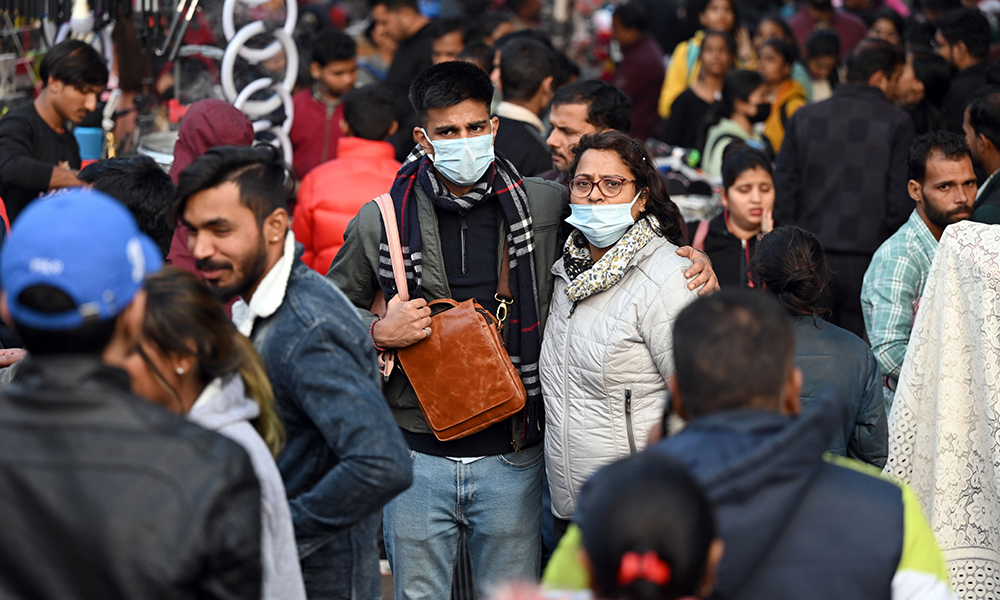
你可能还记得2022年秋天在新加坡掀起风暴的XBB变体——迄今为止最具免疫逃避能力的变体。加拿大的生物学教授瑞安·格雷戈里将其称为“鹰头狮”(希腊神话中的生物,拥有狮子的身体及鹰的头、喙和翅膀)——他还为其他变体取了很多类似的名字——如今,代号为“鹰头狮”的新冠病毒变体在全球的地位已经不如当年。目前,它的后代正在世界各地争夺主导地位。由于感染病例激增,专家们正在密切关注(也是格雷戈里命名的)绰号名为“克拉肯”(北海巨妖)的新冠病毒新变体XBB.1.5。
然而,印度最近的一份报告提供了一些安慰人心的消息。2022年下半年,在印度马哈拉施特拉邦调查的85名感染新冠病毒变体XBB的患者中,大多数人(88%)是有相应症状的,但其中大多数人(79%)能够居家康复,不需要去医院治疗。这项研究(尚未经过同行评审)也带来了好消息,新冠病毒变体XBB的重症率和致死率皆有所下降。
根据1月6日发表在隶属于耶鲁大学(Yale University)的预印本存储库medRxiv上的研究报告,绝大多数患者(96%)可以幸存下来,其中只有3例死亡病例。
感染新冠病毒变体XBB的患者最常见的症状是发烧,近四分之三感染新冠病毒变体XBB的患者都有这种症状。其他常见症状分别是流鼻涕、咳嗽、喉咙痛、肌肉疼痛和疲劳/虚弱。没有感染XBB的患者出现胸痛或皮疹的症状。只有少数人出现呼吸短促、味觉或嗅觉丧失,或腹泻或呕吐等胃肠道症状。
作者写道,在印度,感染XBB家族的患者“症状较轻”,这里指的是新冠病毒变体XBB本身,以及XBB.1、XBB.2、XBB.3和XBB.5等XBB后代。
然而,这项研究的作者警告说,鉴于突变使其能够逃避先前感染和疫苗接种获得的免疫力,并可以更有效地传染他人,该变体有可能迅速在全世界传播。
所有接受采访的新冠确诊患者的症状都相当相似,包括那些感染BA.2家族、BA.5家族和BQ.1变体的患者。感染BA.2.38、BA.2.75和XBB家族变体的患者往往更容易出现头痛和呼吸困难。
绝大多数(约90%)的研究参与者都接种了疫苗,包括感染XBB家族的患者。大多数感染XBB的患者(76%)接种了两剂疫苗,略多于五分之一的患者接种了加强针。只有四人未接种疫苗。作者警告说,研究参与者的高接种率可能导致了感染XBB变体的患者普遍症状温和。
根据世界卫生组织(World Health Organization)的说法,XBB是BA.2衍生出来的两个变异株BA.2.75和BA.2.10.1的重组或组合。这一变体于2022年8月首次被发现,并于去年秋天在新加坡导致感染病例激增,成为头条新闻。不过,新加坡的卫生部部长指出,与BA.5相比,感染XBB变体的患者住院风险似乎低了大约30%。最终,XBB变体也在印度、孟加拉国、马来西亚和亚洲其他地区占据了主导地位。
美国疾病控制与预防中心(Centers for Disease Control and Prevention)在1月13日表示,两周前18%的美国新冠肺炎确诊病例感染了被称为“克拉肯”的XBB衍生变体XBB.1.5。根据欧洲疾病预防与控制中心(European Centre for Disease Prevention and Control)在1月5日的一份备忘录,预计上周将有28%的确诊病例感染XBB.1.5,使其成为美国第二大最常见的变体,并有望在美国占据主导地位。
由于感染病例激增,专家们正在密切关注该变体。据欧洲疾病预防与控制中心估计,每九天感染人数就会增加一倍。
世界卫生组织的官员在两周前说,XBB.1.5正在美国东北部地区肆虐,目前尚不清楚该变体是否导致了美国东北部地区住院治疗人数增加。但专家在上周告诉《财富》杂志,“克拉肯”可能至少在一定程度上导致了该地区住院人数上升,而且西部各州感染XBB.1.5的患者呈上升趋势,因此,感染人数上升可能会扩散到其他地区。
虽然现在下定论还为时过早,但XBB.1.5被认为不会导致更严重的疾病。有关官员在1月11日说,世界卫生组织将继续称其为奥密克戎,而不会为其指定一个新的希腊字母,理由是它与其他奥密克戎变体的差异并不大,不需要使用一个新的希腊字母来命名它。(财富中文网)
译者:中慧言-王芳
你可能还记得2022年秋天在新加坡掀起风暴的XBB变体——迄今为止最具免疫逃避能力的变体。加拿大的生物学教授瑞安·格雷戈里将其称为“鹰头狮”(希腊神话中的生物,拥有狮子的身体及鹰的头、喙和翅膀)——他还为其他变体取了很多类似的名字——如今,代号为“鹰头狮”的新冠病毒变体在全球的地位已经不如当年。目前,它的后代正在世界各地争夺主导地位。由于感染病例激增,专家们正在密切关注(也是格雷戈里命名的)绰号名为“克拉肯”(北海巨妖)的新冠病毒新变体XBB.1.5。
然而,印度最近的一份报告提供了一些安慰人心的消息。2022年下半年,在印度马哈拉施特拉邦调查的85名感染新冠病毒变体XBB的患者中,大多数人(88%)是有相应症状的,但其中大多数人(79%)能够居家康复,不需要去医院治疗。这项研究(尚未经过同行评审)也带来了好消息,新冠病毒变体XBB的重症率和致死率皆有所下降。
根据1月6日发表在隶属于耶鲁大学(Yale University)的预印本存储库medRxiv上的研究报告,绝大多数患者(96%)可以幸存下来,其中只有3例死亡病例。
感染新冠病毒变体XBB的患者最常见的症状是发烧,近四分之三感染新冠病毒变体XBB的患者都有这种症状。其他常见症状分别是流鼻涕、咳嗽、喉咙痛、肌肉疼痛和疲劳/虚弱。没有感染XBB的患者出现胸痛或皮疹的症状。只有少数人出现呼吸短促、味觉或嗅觉丧失,或腹泻或呕吐等胃肠道症状。
作者写道,在印度,感染XBB家族的患者“症状较轻”,这里指的是新冠病毒变体XBB本身,以及XBB.1、XBB.2、XBB.3和XBB.5等XBB后代。
然而,这项研究的作者警告说,鉴于突变使其能够逃避先前感染和疫苗接种获得的免疫力,并可以更有效地传染他人,该变体有可能迅速在全世界传播。
所有接受采访的新冠确诊患者的症状都相当相似,包括那些感染BA.2家族、BA.5家族和BQ.1变体的患者。感染BA.2.38、BA.2.75和XBB家族变体的患者往往更容易出现头痛和呼吸困难。
绝大多数(约90%)的研究参与者都接种了疫苗,包括感染XBB家族的患者。大多数感染XBB的患者(76%)接种了两剂疫苗,略多于五分之一的患者接种了加强针。只有四人未接种疫苗。作者警告说,研究参与者的高接种率可能导致了感染XBB变体的患者普遍症状温和。
根据世界卫生组织(World Health Organization)的说法,XBB是BA.2衍生出来的两个变异株BA.2.75和BA.2.10.1的重组或组合。这一变体于2022年8月首次被发现,并于去年秋天在新加坡导致感染病例激增,成为头条新闻。不过,新加坡的卫生部部长指出,与BA.5相比,感染XBB变体的患者住院风险似乎低了大约30%。最终,XBB变体也在印度、孟加拉国、马来西亚和亚洲其他地区占据了主导地位。
美国疾病控制与预防中心(Centers for Disease Control and Prevention)在1月13日表示,两周前18%的美国新冠肺炎确诊病例感染了被称为“克拉肯”的XBB衍生变体XBB.1.5。根据欧洲疾病预防与控制中心(European Centre for Disease Prevention and Control)在1月5日的一份备忘录,预计上周将有28%的确诊病例感染XBB.1.5,使其成为美国第二大最常见的变体,并有望在美国占据主导地位。
由于感染病例激增,专家们正在密切关注该变体。据欧洲疾病预防与控制中心估计,每九天感染人数就会增加一倍。
世界卫生组织的官员在两周前说,XBB.1.5正在美国东北部地区肆虐,目前尚不清楚该变体是否导致了美国东北部地区住院治疗人数增加。但专家在上周告诉《财富》杂志,“克拉肯”可能至少在一定程度上导致了该地区住院人数上升,而且西部各州感染XBB.1.5的患者呈上升趋势,因此,感染人数上升可能会扩散到其他地区。
虽然现在下定论还为时过早,但XBB.1.5被认为不会导致更严重的疾病。有关官员在1月11日说,世界卫生组织将继续称其为奥密克戎,而不会为其指定一个新的希腊字母,理由是它与其他奥密克戎变体的差异并不大,不需要使用一个新的希腊字母来命名它。(财富中文网)
译者:中慧言-王芳
You may remember the XBB variant that took Singapore by storm last fall—one of the most immune-evasive yet. Dubbed “Gryphon” by the Canadian biology professor Ryan Gregory—who has a lot more names like it for other variants—after the mythical amalgamation of eagle and lion, it’s less of a global player than it was then. Now its descendants are battling for dominance throughout the world. Experts are keeping a close eye in particular on (the also Gregory-monikered) “Kraken” XBB.1.5, due to its ability to grow at a breakneck pace.
A recent report out of India offers some comfort, however. Of 85 patients with XBB variants surveyed in Maharashtra, India, during the later half of 2022, most (88%) were symptomatic, but the majority of them (79%) were able to cope with infection at home, versus in a hospital. The study (which has not yet been peer reviewed) also had good news about survival and symptoms.
The vast majority of the patients (96%) survived, with only three deaths among the group, according to the study, published Jan. 6 on Yale University-affiliated preprint repository medRxiv.
Fever was the most common symptom among the group, with nearly three-quarters of XBB-variant patients experiencing it. Runny nose, cough, sore throat, muscle pain, and fatigue/weakness were the second, third, fourth, and fifth most common, respectively. No XBB-variant patients experienced chest pain or skin rash. And only a handful experienced shortness of breath, loss of taste or smell, or GI symptoms such as diarrhea or vomiting.
XBB COVID variants are causing “mild disease in India,” the authors wrote, referring to the XBB variant itself, as well as offspring variants like XBB.1, XBB.2, XBB.3, and XBB.5.
Authors of the study warned, however, that the variant has the potential to spread around the world rapidly, given mutations that allow it to escape immunity from prior infection and vaccination, and infect others more effectively.
Symptoms were fairly similar among all COVID patients interviewed, including those with BA.2-family, BA.5-family, and BQ.1 variants. Patients with BA.2.38, BA.2.75, and XBB-family variants, however, tended to experience headache and breathlessness at a greater rate.
The vast majority—around 90%—of the study’s participants were vaccinated, including XBB-family patients. Most XBB patients (76%) had received two doses, and a little more than a fifth had been boosted. Only four were unvaccinated. Study participants’ high rate of vaccination may have contributed to the generally mild presentation of XBB variants, the authors cautioned.
XBB is a recombinant, or combination, of two BA.2 variants: BA.2.75 and BA.2.10.1, according to the World Health Organization. The variant was first discovered in August 2022 and made headlines when it spiked in Singapore in last fall, though the country’s minister of health noted that it seemed to carry a roughly 30% lower risk of hospitalization when compared to BA.5. Eventually XBB also became dominant in India, Bangladesh, Malaysia, and other parts of Asia.
XBB spinoff XBB.1.5, dubbed “Kraken,” was behind 18% of U.S. COVID two weeks ago, the Centers for Disease Control and Prevention (CDC) said on January 13. It’s projected to fuel 28% of cases last week, making it the second most common variant in the U.S.—and putting it on track to become the most dominant in the States, according to a Jan. 5 memo from the European Centre for Disease Prevention and Control (ECDC).
Experts are keeping a close eye on it due to its rapid growth rate. It is estimated to double the number of those it sickens every nine days, according to the CDC’s European counterpart.
It’s unknown whether the variant is contributing to a rise in hospitalizations in the northeast U.S., where it’s thriving, WHO officials said two weeks ago. But experts told Fortune last week that Kraken is likely playing at least a part in the regional rise in hospitalizations—and that the rise could spread geographically, as case levels of the new variant trend upward in western states.
While it’s too early to say definitively, XBB.1.5 is not thought to cause more severe disease. The World Health Organization will continue to refer to it as Omicron and will not assign it a new Greek letter, officials said on January 11, arguing it doesn’t differ enough from other Omicron variants to warrant one.






